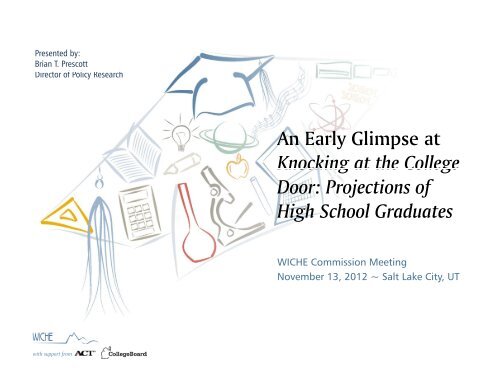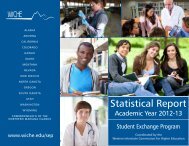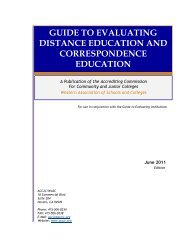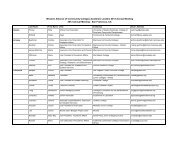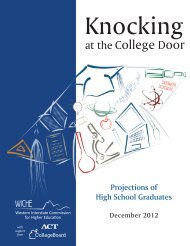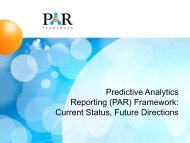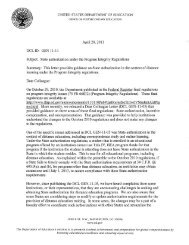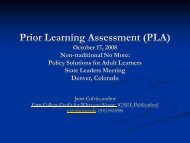Projections of High School Graduates - WICHE
Projections of High School Graduates - WICHE
Projections of High School Graduates - WICHE
Create successful ePaper yourself
Turn your PDF publications into a flip-book with our unique Google optimized e-Paper software.
Presented by:<br />
Brian T. Prescott<br />
Director <strong>of</strong> Policy Research<br />
An Early Glimpse at<br />
Knocking at the College<br />
Door: <strong>Projections</strong> <strong>of</strong><br />
<strong>High</strong> <strong>School</strong> <strong>Graduates</strong><br />
<strong>WICHE</strong> Commission Meeting<br />
November 13, 2012 ~ Salt Lake City, UT<br />
with support from
Background<br />
• Eighth edition to be released this winter<br />
• <strong>Projections</strong> <strong>of</strong> high school graduates by state and<br />
race/ethnicity, including nonpublic graduates<br />
• Actual data through 2008-09; 09; projections spanning<br />
2009-10 through 2027-28<br />
• Audience<br />
• Federal, state, and local policymakers and agency staff<br />
• Institutions: colleges and universities, public and private<br />
schools<br />
• Media<br />
• Researchers<br />
• Others
• Questions<br />
Methodology Review<br />
• Are we employing the best possible forecasting methods, given<br />
data availability, level l <strong>of</strong> effort, and other trade<strong>of</strong>fs<br />
• In what ways might we extend the analysis to make it more<br />
useful to policymakers and planners<br />
• Process<br />
• Background paper<br />
• Technical review panel<br />
• End user review panel<br />
• What we learned<br />
• Retain cohort survival rate as basic methodology<br />
• Transparent, straightforward, and consistent arithmetic<br />
• Analysis unclouded by broad implications<br />
• More regular updates would be helpful<br />
• Resist the temptation to be Nostradamus
Caveat Emptor<br />
• Assumed existing patterns continue indefinitely<br />
• Policy changes not explicitly modeled<br />
• Changes in accountability policies (i.e., high-stakes tests)<br />
• Variations in funding levels that affect progression<br />
• Underlying data<br />
• Reflect the 2008 recession but not all years <strong>of</strong> continued<br />
economic slump<br />
• May reflect small ‘bumps’ from the Federal race/ethnicity<br />
classification change<br />
classification change<br />
• Focus is on the traditional pipeline exclusively
A Few Contextual Features<br />
• Fertility rates declining across the board<br />
120<br />
100<br />
80<br />
60<br />
40<br />
20<br />
0<br />
All origins Hispanic White non-Hispanic Black non-Hispanic<br />
2004 2007 2009 2010<br />
• Slowing immigration among Latinos (Pew,<br />
Census Bureau)<br />
• Impacts <strong>of</strong> the recession shifting students<br />
around<br />
N F ili h b f li bi h 1 000 d 15 44 Bi h d f ili f 2001 2009 h i hi<br />
Notes: Fertility rates measure the number <strong>of</strong> live births per 1,000 women aged 15 to 44. Birth and fertility rates for 2001–2009 shown in this<br />
report were revised using (intercensal) population estimates based on the 2000 and 2010 census. The revised rates may differ from the rates<br />
published previously, which were based 2000 (postcensal) population estimates.<br />
Source: National Vital Statistics Report, Volume 61, Number 1, August 2012, Tables 1 and 5.
<strong>Projections</strong> <strong>of</strong> Postsecondary Enrollment<br />
<strong>of</strong> Adults 25 and Older<br />
10.0<br />
9.5<br />
9.0<br />
• Adult enrollment is<br />
8.5<br />
projected to grow<br />
8.0<br />
by 25.4 percent<br />
7.5<br />
between Fall 2008<br />
70 7.0<br />
and Fall 2019.<br />
Millions<br />
6.5<br />
6.0<br />
55 5.5<br />
5.0<br />
Source: National Center for Education Statistics, <strong>Projections</strong> <strong>of</strong> Education Statistics<br />
to 2019, Table 21.
U.S. Public and Nonpublic <strong>High</strong> <strong>School</strong><br />
<strong>Graduates</strong>, 1996-9797 to 2027-28<br />
28<br />
3.6<br />
3.4<br />
3.2<br />
3.0<br />
illions<br />
M<br />
2.8<br />
2.6<br />
2.4<br />
2.2
U.S. Public and Nonpublic <strong>High</strong> <strong>School</strong> Grad-<br />
uates, Comparison <strong>of</strong> 2008 & 2012 <strong>Projections</strong><br />
3.6<br />
3.4<br />
3.2<br />
Mil llions<br />
3.0<br />
28 2.8<br />
2012 Actual<br />
2012 <strong>Projections</strong><br />
2008 Actual<br />
2008 <strong>Projections</strong><br />
2.6<br />
2.4<br />
2.2
1.4<br />
U.S. Public and Nonpublic <strong>High</strong> <strong>School</strong><br />
<strong>Graduates</strong> by Region, 2003-04 04 to 2027-2828<br />
1.3<br />
1.2<br />
South<br />
1.1<br />
1.0<br />
Millions<br />
0.9<br />
08 0.8 West<br />
0.7<br />
0.6<br />
Midwest<br />
Northeast<br />
0.5<br />
0.4
Public and Nonpublic <strong>High</strong> <strong>School</strong> <strong>Graduates</strong> by<br />
Region, Cumulative Percent Change from 2008-09<br />
15%<br />
10% South<br />
5%<br />
West<br />
0%<br />
Midwest<br />
-5%<br />
Northeast<br />
-10%<br />
-15%
Percent Change Between 2008-09 and 2019-20<br />
in Total <strong>High</strong> <strong>School</strong> <strong>Graduates</strong>, by State<br />
t<br />
AK<br />
WA<br />
OR<br />
NV<br />
CA<br />
HI<br />
ID<br />
AZ<br />
UT<br />
MT<br />
WY<br />
CO<br />
NM<br />
VT NH ME<br />
ND<br />
MN<br />
MA<br />
SD WI<br />
NY<br />
MI<br />
RI<br />
IA<br />
PA<br />
CT<br />
NE<br />
NJ<br />
OH<br />
MD<br />
IL IN<br />
WV DE<br />
KS<br />
VA<br />
MO KY<br />
DC<br />
TN<br />
NC<br />
OK<br />
AR<br />
SC<br />
MS AL GA<br />
LA<br />
TX<br />
Decline Growth<br />
FL
U.S. Public <strong>High</strong> <strong>School</strong> <strong>Graduates</strong> by<br />
Race/Ethnicity, i 2008-09, 09 2014-15, 15 and 2019-20<br />
7%<br />
2008-09 (Actual)<br />
2014-15 (Projected)<br />
e 2019-20 (Projected)<br />
6%<br />
5%<br />
15%<br />
14%<br />
13%<br />
55%<br />
58%<br />
63%<br />
16%<br />
21%<br />
24%<br />
American Indian/Alaska Native<br />
23%<br />
Asian/Pacific ifi Islander<br />
Black non-Hispanic<br />
Hispanic<br />
White non-Hispanic
Proportion <strong>of</strong> Minority Public <strong>High</strong> <strong>School</strong><br />
<strong>Graduates</strong>, 2019-20 (Projected)<br />
AK<br />
WA<br />
OR<br />
NV<br />
CA<br />
HI<br />
NH ME<br />
MT ND<br />
VT<br />
MN<br />
MA<br />
ID<br />
SD WI<br />
NY<br />
WY<br />
MI<br />
IA<br />
PA<br />
CT RI<br />
NE<br />
NJ<br />
OH<br />
MD<br />
UT<br />
IL IN<br />
CO<br />
WV DE<br />
KS<br />
VA<br />
MO KY<br />
DC<br />
TN<br />
NC<br />
AZ NM OK<br />
AR<br />
SC<br />
MS AL GA<br />
TX LA<br />
FL<br />
≤ 10% 50% +
Public <strong>High</strong> <strong>School</strong> <strong>Graduates</strong> in the West by Race/Ethnicity,<br />
1996-97 to 2008-09 (Actual); 2009-10 to 2027-28 (Projected)<br />
900,000<br />
800,000<br />
700,000<br />
600,000<br />
500,000<br />
400,000<br />
300,000000<br />
200,000<br />
100,000<br />
0<br />
White non-Hispanic Hispanic Black non-Hispanic Asian/Pacific Islander American Indian/Alaska Native
Production and Diversification <strong>of</strong> Western States’<br />
Projected Public <strong>High</strong> <strong>School</strong> <strong>Graduates</strong> by 2020<br />
18%<br />
<strong>of</strong><br />
White Share<br />
020<br />
ange in Non-W<br />
SGs, 2009-20<br />
ge Point Cha<br />
Public HS<br />
Percentag<br />
16%<br />
14%<br />
12%<br />
10%<br />
8%<br />
6%<br />
4%<br />
2%<br />
Slowing production,<br />
Rapid diversification<br />
MT<br />
AK<br />
OR<br />
CA ND<br />
HI<br />
Slowing production,<br />
Incremental diversification<br />
AZ<br />
US<br />
WA<br />
SD<br />
NM<br />
WY<br />
ID<br />
NV<br />
CO<br />
Increasing production,<br />
Rapid diversification<br />
0%<br />
-15% -10% -5% 0% 5% 10% 15% 20% 25%<br />
Percent Change in Total Production, 2009-2020<br />
UT<br />
Increasing production,<br />
Incremental diversification
Admissions Hysteria!!!!!!<br />
“Moms Quit Jobs for their Child’s College Dreams” (CNN.com,<br />
4.27.2010)<br />
2010)<br />
“There are few experiences short <strong>of</strong> death, disease, injury or divorce<br />
that have as much potential for trauma for American families as the<br />
college admissions process. The first great rite <strong>of</strong> passage for young<br />
humans once was killing a wild animal. That was replaced by getting<br />
married, or getting a job. These days it is getting into college. ” (Jay<br />
Mathews, washingtonpost.com, 5.23.2010)<br />
“The [admissions] process is far too important to the nation to be left<br />
[ ] p p<br />
solely in the hands <strong>of</strong> a few college administrators who are reluctant<br />
to explain their selections standards or model.” (Andy Pettis, editorial<br />
in The Washington Post, 5.16.2010)
100%<br />
90%<br />
80%<br />
70%<br />
60%<br />
50%<br />
20%<br />
Public Institutions’ Growing Dependence on<br />
Net Tuition Revenue<br />
Share <strong>of</strong> Discretionary Revenue,<br />
United States, 1986-2011<br />
76.8%<br />
23.2% 2%<br />
56.9%<br />
State<br />
Net Tuition<br />
Revenue Share<br />
Change in %<br />
Points Since<br />
1986<br />
Colorado 65.0% 24.9<br />
South Dakota 57.8% 22.8<br />
Oregon 56.4% 30.0<br />
Montana 52.8% 35.9<br />
North Dakota 49.6% 22.5<br />
Arizona 46.4% 22.7<br />
Utah 44.8% 24.5<br />
40% Washington 34.5% 12.8<br />
43.1%<br />
30%<br />
Hawaii 32.4% 23.6<br />
Idaho 31.4% 17.5<br />
10%<br />
0%<br />
19 986<br />
19 987<br />
19 988<br />
19 989<br />
19 990<br />
19 991<br />
19 992<br />
19 993<br />
19 994<br />
19 995<br />
19 996<br />
19 997<br />
19 998<br />
19 999<br />
20 000<br />
20 001<br />
20 002<br />
20 003<br />
20 004<br />
20 005<br />
20 006<br />
20 007<br />
20 008<br />
20 009<br />
20 010<br />
20 011<br />
Net Tuition Revenue<br />
Educational Appropriations<br />
Nevada 30.5% 8.4<br />
California 27.4% 16.6<br />
Alaska 27.1% 16.7<br />
New Mexico 21.9% 82 8.2<br />
Wyoming 11.4% 2.0<br />
Source: SHEEO SHEF
Pressure to Devote Additional Resources<br />
to Recruitment<br />
Applications<br />
Up<br />
Yield<br />
Down<br />
Tepid HSG<br />
pool<br />
Cost<br />
shifting<br />
Enrollment<br />
targets
Voices From the Enrollment<br />
Management Trenches<br />
“None <strong>of</strong> us would ever want to see the day when we had<br />
to choose whether h to spend our resources on excellence<br />
or access. Put more starkly: We never want our values to<br />
depend on the markets.”<br />
- Raynard Kington, President <strong>of</strong> Grinnell College<br />
“A lot <strong>of</strong> institutions are asking, ‘Can we afford our<br />
values’ ’And dthe answer is: We can’t.” ’t”<br />
- a vice president at a private non-pr<strong>of</strong>it college<br />
“How do we back away from students who are least likely<br />
to succeed, and replace them with students who are most<br />
likely to succeed”<br />
- an enrollment management consultant
Percent <strong>of</strong> Dependent Students Receiving Grants and Average<br />
Amount Received by Source <strong>of</strong> Grant and Income Quartile,<br />
2007-08<br />
80% $8,000<br />
70%<br />
$7,000<br />
60%<br />
$6,000<br />
50%<br />
$5,000<br />
40%<br />
30%<br />
20%<br />
10%<br />
0%<br />
$4,000<br />
$3,000<br />
$2,000<br />
$1,000<br />
$0<br />
Lowest Second Third <strong>High</strong>est<br />
Lowest Second Third <strong>High</strong>est<br />
Quartile Quartile Quartile Quartile Quartile Quartile Quartile Quartile<br />
65.4 4%<br />
33.4%<br />
29 9.0%<br />
22.1%<br />
24.9 9%<br />
.4%<br />
4%<br />
28<br />
0.5%<br />
15.5%<br />
27.<br />
0.6%<br />
10.9%<br />
25.0 0%<br />
$3,529<br />
$2, 916<br />
$4,580<br />
$5,654<br />
$6, ,861<br />
$2,093<br />
$2,8 831<br />
$2,35 57<br />
$2,50 09<br />
$2,7 783<br />
$2,7 785<br />
$7 7,155<br />
Source: NPSAS
Percent <strong>of</strong> Dependent Students at Public Four-Year Institutions<br />
Receiving Grants and Average Amount Received by Source <strong>of</strong><br />
Grant and Income Quartile, 2007-08<br />
80%<br />
$8,000<br />
70%<br />
$7,000<br />
60%<br />
$6,000<br />
50%<br />
$5,000<br />
40%<br />
76.4%<br />
$4,000<br />
30%<br />
$3,000<br />
20%<br />
10%<br />
0%<br />
48.4%<br />
33.5%<br />
26.1 1%<br />
35.7%<br />
3 1.2%<br />
0.5%<br />
18.3%<br />
24.5 5%<br />
0.6%<br />
13.4%<br />
19.2%<br />
Lowest Second Third <strong>High</strong>est<br />
Quartile Quartile Quartile Quartile<br />
$2,000<br />
$1,000<br />
$0<br />
$3,849<br />
$3,436<br />
$3,831<br />
$2,22 23<br />
$3 3,138<br />
$3,663<br />
$2, 760<br />
$4,041<br />
$3 3,081<br />
$3,993<br />
Lowest Second Third <strong>High</strong>est<br />
Quartile Quartile Quartile Quartile<br />
Source: NPSAS
State Policy Areas to Address These Shifts<br />
• State goals that include targets for<br />
underrepresented populations<br />
• Standards alignment and equal expectations for<br />
all<br />
• Appropriately targeted and incentivized state<br />
finance policies<br />
i<br />
• Enrollment management policies that are<br />
consistent t with state t goals
Questions<br />
Brian T. Prescott, Ph.D.<br />
Director <strong>of</strong> Policy Research,<br />
Policy Analysis & Research<br />
Western Interstate Commission for<br />
<strong>High</strong>er Education<br />
3035 Center Green Drive, Suite 200<br />
Boulder, CO 80301-2204<br />
303.541.0255<br />
bprescott@wiche.edu


